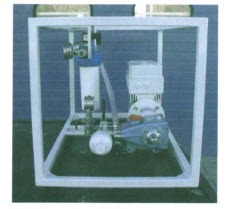Case study 8: Benefits given by the use of environmental temperature control using reciprocating PD pumps driven by VSD
Case study summary
Reciprocating positive displacement pumps were used for the application of temperature control in a paper mill, where the requirement was for a variable flow rate of demineralised water.
To cool high ambient temperatures for a number of applications, the technique of atomizing water into fine droplets was employed.
The performance required was from 0.1 1/min to 3.0 1/min at pressures up to 80 bar. The duty involved cooling the environment surrounding the paper forming process to prevent premature drying.
Installed details
The PD pumps chosen were powered by an electric motor controlled by an integrated electronic variable frequency drive.
The water, vaporized at the nozzles, lowers the temperature by absorbing its latent heat of vaporization.
By linking a temperature sensor via a programmable logic controller (PLC) to the variable frequency drive it is possible to control the volume of water discharged, and hence the resulting temperature.
General benefits seen by the use of VSD PD pumps
The energy that was wasted and returned to the water source was dissipated mainly as heat as it is passed through the regulator . By not pumping at full output this energy wastage is reduced. The alternative would be to run the pump at full flow and use a pressure regulating valve opening to control the feed to the nozzles. The excess flow would then have to be diverted back to source via a pressure regulator, which would require a much larger source tank to ensure that the water temperature rise was acceptable.
As well as the long-term continual energy savings seen by using a VSD pump, rather than wasting energy and dissipating pressure across a valve, the response from a VFD allows improved system controllability.
